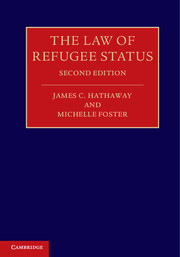Book contents
- Frontmatter
- Contents
- Acknowledgments
- Table of cases
- Table of treaties and other international instruments
- Abbreviations for courts and tribunals cited
- Introduction
- 1 Alienage
- 2 Well-founded fear
- 3 Serious harm
- 4 Failure of state protection
- 5 Nexus to civil or political status
- 6 Persons no longer needing protection
- 7 Persons not deserving protection
- Index
- References
4 - Failure of state protection
Published online by Cambridge University Press: 05 July 2014
- Frontmatter
- Contents
- Acknowledgments
- Table of cases
- Table of treaties and other international instruments
- Abbreviations for courts and tribunals cited
- Introduction
- 1 Alienage
- 2 Well-founded fear
- 3 Serious harm
- 4 Failure of state protection
- 5 Nexus to civil or political status
- 6 Persons no longer needing protection
- 7 Persons not deserving protection
- Index
- References
Summary
Refugee law is not simply a system designed to enable persons to escape the risk of serious harm. While the duties of state parties to the Refugee Convention are, of course, engaged only when there is a risk of serious harm of the kind discussed in the preceding chapter, the more fundamental purpose of the Refugee Convention is
to serve as a back-up to the protection one expects from the State of which an individual is a national.
More specifically,
[t]he general purpose of the Convention is to enable the person who no longer has the benefit of protection against persecution for a Convention reason in his own country to turn for protection to the international community.
Refugee law is thus principally concerned with providing a remedy to a fundamental breakdown in the relationship between an individual and her state. As described in Chapter 1, the Refugee Convention’s overarching goal is to provide a new national home to persons driven from their own country by the risk of being persecuted. Specifically, refugee law seeks to enfranchise an at-risk subset of persons who are “outside their own countries [and] who lackthe protection of a government.” It provides these involuntary migrants with legal status and protection to offset the disabilities of presence outside their own country until and unless they acquire new or renewed national protection. This commitment to providing surrogate or substitute national protection is grounded both in the basic commitment of the interstate system to ensuring that all individuals have a nationality in the legally recognized form of citizenship, and are thus effectively “allocated” to a state, and also in the recognition that nationality provides the essential means by which individuals are able to avail themselves of the full range of protections established by international law.
- Type
- Chapter
- Information
- The Law of Refugee Status , pp. 288 - 361Publisher: Cambridge University PressPrint publication year: 2014



